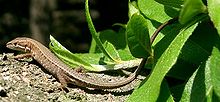Takydromus tachydromoides
Appearance
| Takydromus tachydromoides | |
|---|---|

| |
| Scientific classification | |
| Domain: | Eukaryota |
| Kingdom: | Animalia |
| Phylum: | Chordata |
| Class: | Reptilia |
| Order: | Squamata |
| Family: | Lacertidae |
| Genus: | Takydromus |
| Species: | T. tachydromoides
|
| Binomial name | |
| Takydromus tachydromoides (Schlegel, 1838)
| |
Takydromus tachydromoides, the Japanese grass lizard, is a wall lizard species of the genus Takydromus. It is found in Japan. Its Japanese name is 'kanahebi' (カナヘビ). 'Hebi' means 'snake' in Japanese, although this lizard is not a snake. There are three lizards found in the four main islands of Japan. The other two are the Japanese gekko (also, Schlegel's Japanese gekko, Gekko japonicus), and the Japanese five-lined skink (Eumeces latiscutatus, also Plestiodon latiscutatus; this skink shows five lines only as a juvenile).[1]


Live food
References
- ^ Kevin Short, Nature in Tokyo, Kodansha, 2000
Wikimedia Commons has media related to Takydromus tachydromoides.
Wikispecies has information related to Takydromus tachydromoides.

